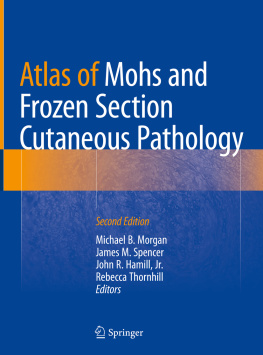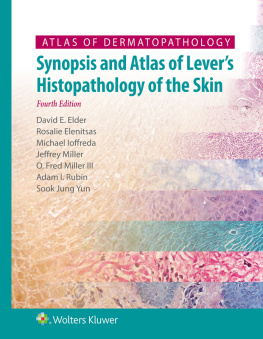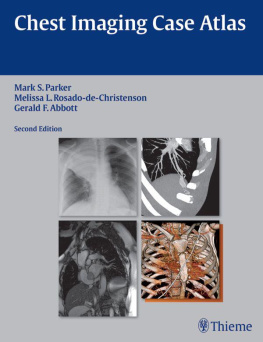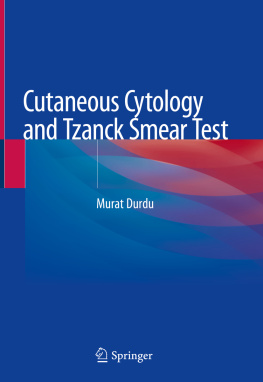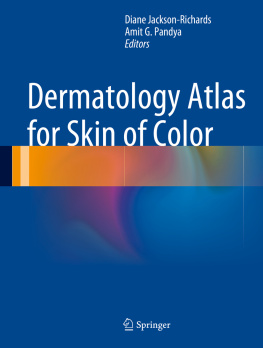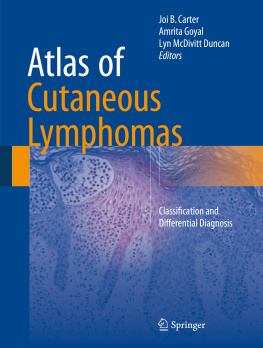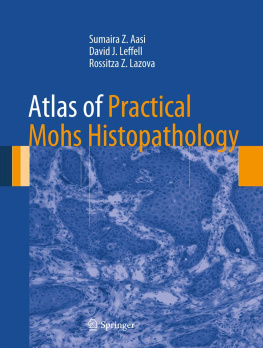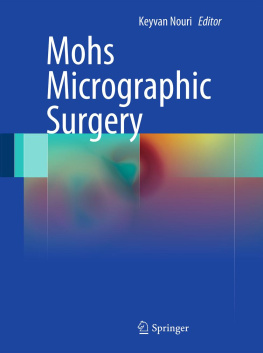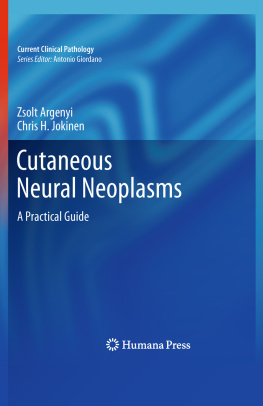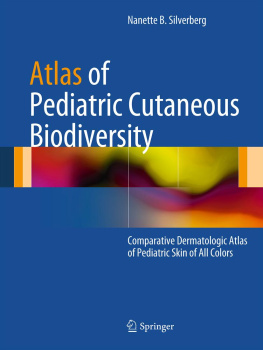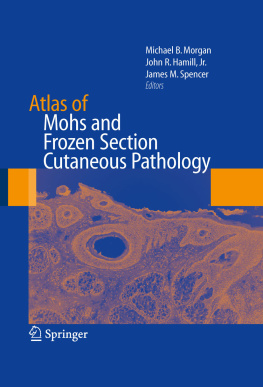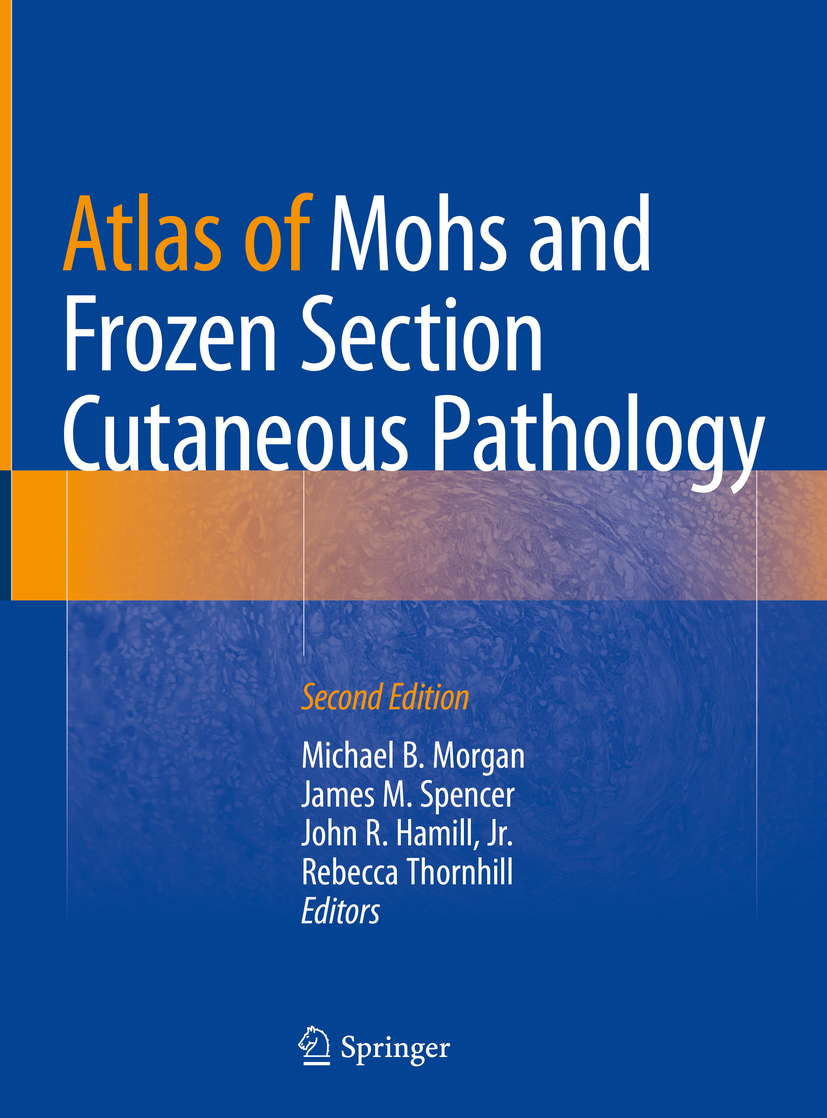Editors
Michael B. Morgan , James M. Spencer , John R. Hamill Jr. and Rebecca Thornhill
Atlas of Mohs and Frozen Section Cutaneous Pathology 2nd ed. 2018
Editors
Michael B. Morgan
College of Medicine, University of South Florida College of Medicine, TAMPA, Florida, USA
James M. Spencer
Suite 404, Spencer Dermatology Suite 404, Saint Petersburg, Florida, USA
John R. Hamill Jr.
Gulf Coast Dermatology, Hudson, Florida, USA
Rebecca Thornhill
Thomas Jefferson University, Sidney Kimmel Medical College Thomas Jefferson University, Philadelphia, Pennsylvania, USA
ISBN 978-3-319-74846-7 e-ISBN 978-3-319-74847-4
https://doi.org/10.1007/978-3-319-74847-4
Library of Congress Control Number: 2018941239
Springer Science+Business Media LLC 2018
This work is subject to copyright. All rights are reserved by the Publisher, whether the whole or part of the material is concerned, specifically the rights of translation, reprinting, reuse of illustrations, recitation, broadcasting, reproduction on microfilms or in any other physical way, and transmission or information storage and retrieval, electronic adaptation, computer software, or by similar or dissimilar methodology now known or hereafter developed.
The use of general descriptive names, registered names, trademarks, service marks, etc. in this publication does not imply, even in the absence of a specific statement, that such names are exempt from the relevant protective laws and regulations and therefore free for general use.
The publisher, the authors and the editors are safe to assume that the advice and information in this book are believed to be true and accurate at the date of publication. Neither the publisher nor the authors or the editors give a warranty, express or implied, with respect to the material contained herein or for any errors or omissions that may have been made. The publisher remains neutral with regard to jurisdictional claims in published maps and institutional affiliations.
This Springer imprint is published by the registered company Springer International Publishing AG part of Springer Nature
The registered company address is: Gewerbestrasse 11, 6330 Cham, Switzerland
Dedication
To Kerry, Poochie, and Bozie for your unconditional love and acceptance of the time and effort I have spent away from you in this endeavor.
Michael B. Morgan, MD
To Glicia and James, thank you for your love and encouragement.
James M. Spencer, MD
I would like to thank my mentor and friend in medical school, Robert Bookmyer, MD, from my dermatology training at the University of Chicago. I would like to thank Alan Lorincz, MD, for inspiring me to think creatively; Maria Medenica, MD, and David Fretzin, MD, for dermatopathology; and Keyoumaris Soltani, MD, for dermatological surgery. I also want to thank Frederick Mohs, MD, for being so generous and sharing his expertise with me. Most importantly, I want to thank my wife Sue and my children John, Sarah, Amy, and Gregory for their support and encouragement.
John R. Hamill, Jr. MD
To my mother, Mary Barber, who has always been my inspiration and to my husband, Christopher, for his unwavering love and support.
Rebecca Thornhill, MD
Preface
This atlas is intended for practitioners in the fields of dermatologic surgery including Mohs cutaneous surgeons, pathologists who examine frozen section specimens derived from the skin, and dermatopathologists. This book will serve as a reference pictorial atlas detailing both common and challenging cutaneous neoplasms. It will also serve as a review for physicians-in-training preparing for certifying examinations in the fields of dermatology, dermatologic surgery, Mohs surgery, pathology, and dermatopathology.
The central theme of the atlas entails the microscopic analysis, diagnosis, and discrimination of common and problematic cutaneous neoplasms as encountered by the dermatologist, cutaneous surgeon, or pathologist employing the frozen section technique. The book includes coverage of (1) microscopic anatomy of the various cutaneous and mucosal sites of the body; (2) diagnosis of basic/routine dermatologic entities including basal cell carcinoma and its variants as well as squamous cell carcinoma and its variants; (3) the discrimination of these foregoing neoplasms from benign epidermal-derived or adnexal-derived neoplasms; (4) diagnosis and distinction of rare and/or deadly neoplasms from benign entities such as dermatofibrosarcoma protuberans and merkel cell carcinoma; (5) troubleshooting and dealing with quality control of the frozen section technique including cutting and staining; (6) new techniques including immunohistochemistry and molecular analysis.
The underlying premise of this atlas is to provide its reader with a single reference atlas dealing with the frozen section microscopic diagnosis of cutaneous neoplasms. As these malignant entities are capable of presenting in a variety of microscopic guises potentially confused with benign mimics or in a subtle fashion easily missed by the examiner, it is important that pathologists or clinicians who interpret their own biopsies are apprised of this risk.
This book should provide a shelf reference for dermatologic surgeons, Mohs cutaneous surgeons, pathologists who perform frozen section analysis of cutaneous specimens, and dermatopathologists. This book should also serve as a potential study source for dermatologists, pathologists, and dermatopathologists preparing for board examinations.
Michael B. Morgan
James M. Spencer
John R. Hamill Jr.
Rebecca Thornhill
Tampa, FL, USA Saint Petersburg, FL, USA Hudson, FL, USA Philadelphia, PA, USA
Prologue
Skin cancer has reached epidemic proportions in the United States, and there is no evidence that this trend will decrease any time soon. Basal cell and squamous cell carcinomas, collectively referred to as nonmelanoma skin cancer, make up the vast majority of the estimated 1.5 million skin cancers seen annually in this country. There are many ways nonmelanoma skin cancer may be treated, ranging from topical medications for early thin tumors, destructive techniques such as cryosurgery or curettage and electrodessication, radiation therapy, surgical excision, and lastly excision utilizing the Mohs technique. Of all these techniques, the highest cure rates currently possible are with the Mohs technique, which relies on optimal preparation and interpretation of frozen sections. Therefore, frozen section analysis has become the gold standard for skin cancer therapy.
When surgical excision is chosen as the treatment, frozen section analysis allows histologic information to become part of therapy, rather than preceding therapy (in the case of a biopsy) or confirming an already finished procedure (permanent sections read days after the surgery is over). Frozen sections may be utilized to sample a portion of a conventional surgical excision, or they may be used to examine all the exterior surface of the excised tumor during the Mohs technique. Cure rates with either conventional surgery or the Mohs technique can only be as good as the quality and interpretation of the frozen sections.

